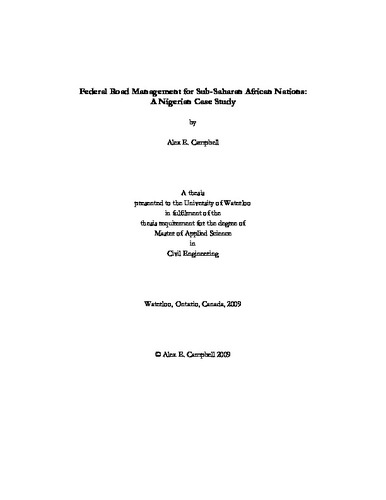| dc.description.abstract | The World Bank specifically indicates that poor transport infrastructure and services in sub-Saharan Africa are serious obstacles to poverty reduction (Plessis-Fraissard, 2007). Two thirds of Africa's rural population, who are some 300 million of the world's poorest people, do not have access to an all-weather road. The same holds true for the federal paved network, further compounding the issues of health and economy. In the case of Nigeria, the majority of their federal network was constructed decades ago and little, if any, pavement management has been conducted. Further, federal roads that have been reconstructed or new roads that have been built are done so with inferior materials, inadequate designs and lack of quality control during the building process. Contributing to the poor state of the federal road network are high traffic volumes and traffic loads, as heavily overloaded trucks are commonplace.
Nigeria has understood the need to improve their federal road network if they are to achieve the Millennium Development Goals they have outlined. As such, the Federal Roads Maintenance Agency (FERMA) was created and set in motion a mandate of federal road improvement through more appropriate design, construction, and above all else, pavement management. The major challenge, however, is that they are starting the process without a database, pavement management system, or an appreciation of the condition of their federal road network.
The primary objective of this thesis is to form the foundation of a pavement management system (PMS) that FERMA can immediately implement to make better decisions pertaining to rehabilitation options. Further, it is the intent to allow for appropriate decisions about the best type of maintenance and rehabilitation interventions to apply to the poor state of arterial roads taking into context various factors, least of which are the type and extent of distress present and the benefit cost analysis. The outcome of this thesis will assist sub-Saharan Africa, but principally Nigeria, in their goal of fostering economic growth and creating a more sustainable transportation network. Recommendations on how to simplify input factors necessary for Nigeria to initiate a database and prepare more regionally specific designs have been made, including traffic, climatic and subgrade classifications. Economic analysis included present worth of costs (PWC) that were derived from condition rating curves specific to intervention pavement life and performance. Based on preliminary findings, subject to field validation, a chip-seal specific rehabilitation strategy for low volume federal roads is more cost effective over the 20-year analysis period, and 1-lift of asphalt concrete (AC) is more cost effective over the 20-year analysis period for high volume federal roads. Recommendations for further research have been made. | en |

